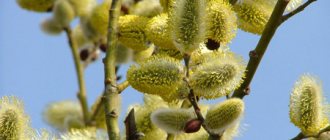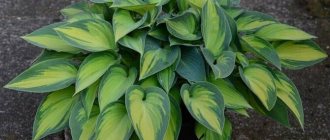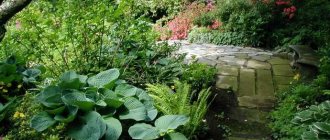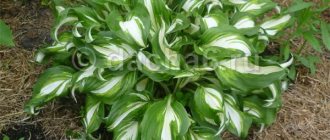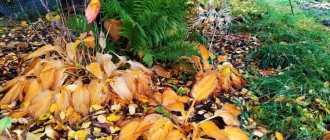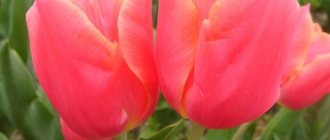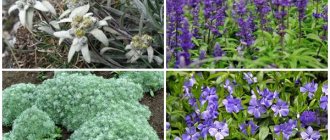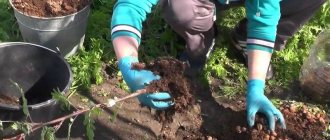Hello, dear readers!
Of course, flowers such as lilies, peonies, roses, and chrysanthemums are beautiful. But before and after their flowering, we don’t often cast admiring glances at them, but hostas are a completely different matter.
Their leaves delight our eyes throughout the summer season; in addition, many varieties also bloom, and some of them exude a simply divine aroma.
We associate elegance, sophistication and beautiful leaf colors with hostas.
Hosta bushes add magical colors to the palette of our gardens, decorating all its shady corners.
A plant with unusually decorative leaves of many shapes, sizes and colors - hosta - grows wild in a number of regions and countries. This:
- Japan;
- Far East;
Southeast Asia;
- Korea;
- China.
Here it was cultivated and introduced into culture thousands of years ago. From warm, humid countries, hosta has spread to many others.
Biologists, breeders, and botanists have adapted the plant to other latitudes. But the host still prefers a warm and humid climate.
Hosta was originally classified as a lily plant, but is now classified as an asparagus plant.
Hosta moved to Europe from Japan relatively recently. The beginning of its march through European countries dates back to the 18th-19th centuries.
Many scientists studied hosta, and at first they called it Funkia - after the name of Funk, a German botanist.
Later the genus was renamed - the plant was studied by an Austrian doctor, the then famous botanist Khosta. The name is in his honor.
Hosta can be planted both in compositions and as single plants (tapeworms). It looks great in its skillfully composed design.
Aureomarginata
This is one of the most popular varieties with a border on the leaves: the glossy dark green leaf blade is decorated with a thin yellow stripe. In the second half of summer, for three weeks, the hosta bush is decorated with bell-shaped flowers of pale purple color.
| Leaf color | Flower color | Bush height (cm) | Bush width (cm) | Flowering time |
| Dark green with yellow border | Light purple | 70-80 | 90-100 | July August |
Biological portrait of hosta
Hosta is a herbaceous perennial with beautiful leaves of various colors. The shape and size of the leaves also vary.
The leaf flower has many interesting features:
- The hosta has no stem, the leaves go in a rosette straight from the root, rising above the ground on strong petioles. The petioles are also different: short, long, medium length.
- The underground part is rhizomatous. The rhizome is short but powerful. It has dense vertical roots. There are hosta species with territorially isolated rhizomes - they grow well in one place and do not disturb the surrounding area. But some spread underground, expelling leaves in other places near the main plant. A large area can be overgrown with such hosta.
- The plant is decorative in itself, and is in perfect harmony with other inhabitants of the garden. To set off and serve other flowers against your background is the task of monochromatic hostas. The bright color of the leaves of some varieties allows them to be included in compositions as an independent eye-catching color scheme.
- The height of the peduncles depends on the variety. It is often large: the plant shoots out a peduncle up to a meter. There are also short hostas. There are no or almost no leaves on the peduncles.
- The flowers are usually inconspicuous, which is compensated by the luxury of the leaves. The color of the funnel-shaped or bell-shaped flowers in a loose cluster has shades of lilac. Sometimes the flowers are white. But the main thing is the leaves.
- The extreme shade tolerance of the hosta allows it to be used to plant trees in the shady corners of gardens and parks. Therefore, “queen of the shadow” is a rightly assigned characteristic to her. Other shade-loving crops are planted next to it, visually harmonizing with the lush foliage of the plant.
- Hostas are divided into groups according to leaf height. But it is a rather free plant, so in the group in which it is classified, different specimens of the “framework” are not recognized. They can be both higher and lower than the average heights accepted for the group. There are six groups in total. From dwarf to very large, called giant. In the group of giants there are record holders who overcome the height of one and a half meters. For comparison: hosta dwarfs are only 10 cm. The height is determined by the petioles. The petioles differ not only in height, they also have different shapes, cross-sections, and some other features.
- The leaves are dense. It is both beautiful and functional. The hosta survives in drought thanks to the density of its leaves. Thin-leaved ones are also found. They tolerate dryness less well, so the shade is a lifesaver for them. Whereas dense-leaved ones can grow without problems in the light.
- The leaves are varied in color and size too. Small-leaved varieties have leaves only 5 cm. Large-leaved varieties - 25 cm.
- The plant is also notable for its leaf diversity. There may be smooth leaves, but there are also wavy, even “corrugated” leaves. The veins are strongly expressed or almost invisible.
- The perenniality of the herbaceous plant is amazing. An ornamental plant can live on its leaves for a quarter of a century. Rarely does any grass “allow” itself to do this. Moreover, the host seems to challenge everyone in nature at once. She doesn't fade as she gets older. It only adds decorativeness, splendor and beauty.
- The plant is unpretentious to conditions, which makes it almost indispensable in green design. As they grow, powerful leaves drown out competitors, so weeds cannot survive nearby.
- Hosta is cold-resistant, this is also a factor that helps its spread.
- There are certain shade queen varieties that can easily “queen” in the light.
- The host shows his individual characteristics in all their glory by the age of eight. All this time she changes, amazes, becomes prettier.
- In autumn, the leaves die off late, retaining their beauty for a long time. But in the spring they also appear late. Therefore, it is good to plant early, short-growing flowers or leafy plants nearby. Otherwise, the decorative quality of the “host” site in March - April will be in question - it will be empty, or weeds will take over. Bulbous perennials such as crocuses or daffodils are perfect. They will have time to bloom early without interfering with the main plant.
Fair Maiden
An exquisite hosta with wavy leaves pointed at the ends, gray-green in color with a white or cream border. In mid-summer, fairly large pale purple flowers bloom on strong peduncles.
| Leaf color | Flower color | Bush height (cm) | Bush width (cm) | Flowering time |
| Gray-green | Light purple | 35 | 45 | July August |
Hosta leaf color
Hosta can be recognized by looking at its morphological characteristics. It would be difficult to determine it by the color of the leaves.
Unless you are the owner of the host botanical garden, a collection of these plants.
The variety of colors is impressive. Hosta in the garden is a treat for the eyes.
In addition to the traditional green color, the leaves can be:
- Blue - with a waxy bluish coating;
- White - either initially or turning white by the end of the growing season;
- Golden - a very unusual, but spectacular look;
- Various shades - with a border, and the border and center are contrasting: either the center is dark, the border is lighter, or vice versa;
- Striped - with stripes of different colors;
- Tricolor with multi-colored border;
- There are silver shades. There are matte leaves and some with a wax-like coating. For every gardening taste. The variety of leaf colors by variety makes gardeners fall in love with it. Moreover, the color of the leaf is often changeable: the plant lives for a long time and gradually changes colors. There are varieties that change color with the seasons. A garden plot with a hosta is transformed many times over, and this is an additional advantage of the decorative queen of shade.
- The color green itself can change shades throughout the season, becoming lighter or darker. Or they may turn yellow. How not to become interested in hosta? She is even attractive in her variability.
The gardener can regulate the color of the leaf himself. The shady the landing site, the more varied the color.
A hosta planted close to light will have more green tones: the sun is a source of chlorophyll.
Large plants usually do not show off variegation; they manage to gain growth and size, forming chlorophyll, which gives it its green color.
There are exceptions to this rule. Some variegated varieties do not show the desired color in the shade and need to be planted in a lighted place.
Can hosta be planted in the sun?
Of course, not every hosta tolerates planting well in bright sun. However, if you choose a specimen of a suitable variety and create favorable conditions for it in a lighted area of the garden, the plant may well feel comfortable.
Today, many hosta varieties have been developed that thrive in the sun.
When deciding which hosta to plant on the sunny side, you need to take into account the following factors:
- Morphological features of the variety. If the hosta has thick, glossy leaves, then its resistance to the sun's rays is definitely higher than that of specimens with thin and matte leaves. The smooth, shiny surface reflects the rays well, and thanks to its dense structure, the green mass retains moisture better.
- Plant coloring. Hostas with yellow and golden leaves tolerate the sun best, even if only the center or edge is colored this color. Varieties with white stripes and spots tolerate excess light somewhat worse. And finally, blue-blue hostas with a waxy coating on the surface of the leaves are exceptionally shade-loving. The sun melts this protective layer, which protects the plant from burns, age spots, fungal diseases, and excessive evaporation of moisture. As a result, the bush ages and dries out prematurely.
- Climatic conditions of the region. If summer comes early and is usually dry and hot, then it will be much more difficult for the hosta to adapt to a sunny area than in conditions where this time of year is usually wet and cool, with a lot of cloudy days. Correct agricultural technology will help correct the conditions set by nature: organizing timely watering and shading the bushes during the midday hours, planting them in the openwork shade of tall bushes and trees.
Important! Hostas growing in a shaded area are usually famous for their large leaves with bright, rich colors, but they develop more slowly. Those that are planted in the sun, with proper care, grow better and bloom more profusely, but at the same time their leaves become smaller and the color may change.
The color of different hosta varieties growing in the light can sometimes deviate quite significantly from the varietal standard:
- green ones fade;
- blues acquire green shades;
- yellow ones either become brighter (in lucent varieties) or turn green (in viridescent varieties).
Warning! Hostas with variegated leaves usually need more light than those with monochromatic leaves.
In any case, it is impossible to predict exactly how a hosta of a particular variety will look and feel growing in the sun. This is usually determined experimentally by planting the bush in appropriate conditions and observing it.
The best popular varieties
Hosta is an excellent material for breeders. This led to the emergence of its varieties that cannot be accurately recorded.
Every year dozens of new ones are introduced: each one is more interesting than the other. And sometimes hosta varieties are barely distinguishable, but still different.
The varieties considered the best can be listed for a long time.
Let's talk about popular ones in our country.
Aureum Maculatus . This species is a swollen hosta. The swollen appearance is called for the corrugated surface of the sheet.
The leaves of the hosta variety Aureum Maculata are not monotonous. The middle of the leaf is lighter than the edges, its color is yellowish with a slight green tint.
This middle of the plate is decorated with stripes of different colors. The stripes are yellow, green or cream. Their color depends on the light, depending on where the bushes are planted.
A dark border is outlined along the edges of the sheet. The variegation of color persists all summer, and at the end of warm days the leaves begin to acquire a green color.
In order for the variety to manifest itself in this way, it is necessary to provide access to light. Planted in the shade, it will not give this beauty; the diversity will quickly disappear.
Erromena . Wavy hosta. The bush is not small, although not a giant: 50 cm height of leaves. The peduncle shoots out up to a meter.
On a loose inflorescence there are lilac five-centimeter bell-shaped flowers.
This variety is attractive with wavy, delicate salad-colored leaves. The flowers are also noticeable and last the last two summer months.
The plant can grow up to 80 cm in width. At the same time, it is completely easy to care for: this hosta is unpretentious.
Erromena tolerates shade and is undemanding to the soil. Loves moisture.
Vaid Brim . Hybrid hosta. The height group is medium. Reaches 60 cm (leaves).
The leaf can exceed 20 cm in length. The color is green, bright, with a light cream-colored border.
The border may be interrupted in places, and the decorativeness even increases. The diameter of the bush is up to a meter.
Winter-hardy, loves moisture, soil nutrition, and drainage. But everything is done in moderation.
As a variegated plant, it avoids shady places - the advantages of the variety will not appear there. Need partial shade or sunny place.
June . Universal variety. You can plant it in the shade, or in the sun. Very beautiful, changes color with the seasons.
She will meet the beginning of summer, dressed up in a leaf with a small yellow central spot and a wide, intense green border.
And by the end of summer the view is completely different. The wide border becomes blue, and the yellow spot turns green.
The bushes are less than half a meter high, but spread 70 cm in width.
June will show the desired color when placed in a location that provides sun in the morning, partial shade and coolness in the afternoon.
Jurassic Park . From the group of giants. The leaf is almost half a meter (up to 45 cm) long, the width is close to the same figure.
The color is green, like most giants - it is important for them to gain more chlorophyll to grow, this is what colors them.
At first the leaf is smooth, but as an adult it is wrinkled and grooved. This variety is very effective. The height of the bush is one meter.
Winter-hardy. Such a colossus simply requires soil fertility, its structure (looseness) and sufficient moisture.
The element of the variety is partial shade, where the plant is comfortable.
Sam and Substance . Another giant. Grows approximately 90 cm. The leaf is glossy, yellow with a green tint.
Large (8 cm) lavender flowers. Not afraid of pests: they do not affect him.
An unpretentious, winter-hardy plant. Loves the sun, waterlogging is undesirable.
The leaves of this hosta are half a meter long. That’s why the bush spreads over one and a half meters.
Winter-hardy, easy to care for. But he loves fertile soil. Partial shade and drainage are desirable.
Sun Power
From the name it is obvious that this is the most sun-loving hosta. In the spring, when daylight hours are still quite short, the color of the leaves of the plant is greenish-yellow, and by mid-June it gradually becomes rich yellow. At the same time, venation is clearly expressed on the leaf plate. In mid-summer, the hosta produces long flower stalks with funnel-shaped flowers of lavender color.
| Leaf color | Flower color | Bush height (cm) | Bush width (cm) | Flowering time |
| Yellow | Purple | 60-70 | 90 | July August |
Landing location
Each owner of a plot or garden decides on the location himself. Landscape design is different for everyone.
Since almost all hosts adore partial shade, they are located by choosing a place in the garden that is not too shady.
But there will be nuances. Variegated varieties need to see the sun for at least some part of the day. Otherwise, the varietal characteristics will be blurred and you won’t get a clear pattern.
There are varieties that clearly prefer shade or sun. You will also have to become familiar with this and provide them with what they want.
The owner of the plot usually knows what the soil of the garden is, whether there is stagnation of water and other conditions.
Therefore there are two options:
- We select a variety for the conditions.
- We create conditions for the variety.
The gardener is usually able to do both.
Desires regarding planting other plants also influence the location. All of them must be accommodated, respecting good neighborliness.
Not only do not interfere, but decorate each other. It is important to take into account the longevity of the shadow queen: two decades without a transplant can make her happy or sad. The last thing is if there is an error with the place.
The hosta will grow slowly in the shade. But it will take all the growth due to it and give the largest possible leaf.
Choose what is more important: speed or view.
It’s better to think about this before planting, and not like this: “I want a hosta, I take it and don’t know where to place this miracle.”
Which host to choose?
The hosta world is surprisingly diverse, and no matter what your garden is, you can always find “your” variety. Hostas vary in size from dwarf (up to 10 cm in height) and miniature (10-23 cm) to very large ones, whose height can reach 90 cm or more. For example, the popular hosta Blue Mouse Ears has a size of only 15x30 cm, and the Blue Angel variety reaches respectable dimensions: 80x100 cm.
The shape of hosta leaves is incredibly diverse. They can be round, heart-shaped, oval, as well as linear-lanceolate, wavy or spiral.
The assortment of the POISK Agroholding includes both varieties tested by gardeners and modern new products, among which you will certainly find varieties and hybrids for every taste and for any garden!
Disembarkation time
Despite its winter hardiness, it is customary to plant hosta in the spring. In warm weather, its survival rate is better.
Before the next winter, the seedling will strengthen and grow. And it will safely survive the cold period.
This is especially important in the first season. Further, the plant is not defenseless.
Another argument in favor of planting in spring is the opportunity to properly and calmly (less work for the gardener) prepare the soil in the fall.
In the fall, the hosta is also sometimes disturbed. But extremely rarely. If it is necessary to divide the bush.
Usually this is not done, but if dividing is necessary, the bush is dug up even earlier - in August, early September.
They divide it and seat it. A divided bush takes a long time to take root, about a month. In the spring it wakes up late, if the wintering was generally successful.
It is better to practice spring division of the bush, focusing on the awakening (growth) of the roots, while the above-ground part is still in the dormant period.
Captain Kirk
This hosta has wrinkled yellow-green leaves with a wide dark green border. The bush grows very quickly if the sun's rays fall on the plant in the morning for several hours. The flowers are pinkish-violet.
| Leaf color | Flower color | Bush height (cm) | Bush width (cm) | Flowering time |
| Yellow-green | Pink-violet | 50-70 | 90 | July August |
Soil preparation
The hosta will remain in its assigned place for many years. Therefore, despite the ease of care, you must first take care of her nutrition.
We prepare the soil in the fall by adding fertilizer before digging (the depth is the size of a shovel). Better organic matter - half-rotted manure, compost.
It depends on the type of soil; if it is poor, we improve both the structure and nutritional value.
In the spring, holes are prepared for planting. The soil in the intended area settled over the winter, and the fertilizer was distributed evenly by snow and rain.
Although the seedling is still small, it will grow and will feed in this place without feeding for many years.
Give him the necessary conditions right away:
- Having dug a hole 35x35 (in centimeters), they begin proper preparation.
- The first thing is drainage. The bottom of the pit is lined with available drainage material: broken brick, crushed stone, gravel or expanded clay. Five centimeters of drainage layer is enough. This will protect the hosta from getting wet in rainy years and when groundwater levels are high.
- Fill the hole with good, nutritious soil - not completely. In the middle there is a hill of soil, a seedling will be placed on it, then covered with earth.
- The filling height is determined by the size of the seedling, especially its roots. It is necessary to place the root system on this soil, already watered, and not allow the roots to bend to the sides. Keep in mind: after sprinkling the roots, the buds should not be covered either.
- The distance between the holes is forty centimeters or more (we take into account the power of the future plant).
- If the soil is not rich in nutrients, in the spring additional fertilizers are added to this soil mixture placed in pits. Better - ash, peat. Organics are no longer needed; minerals in small quantities are ok. Hosta is a powerful, leafy plant, so reasonable doses of one-time planting fertilizer will come in handy.
The hosta can be planted: the soil is ready.
Hosta in Siberia, planting and care in open ground
Flower beds with beautiful flowers enhance the garden area and make it attractive. Not only flowers are used as ornamental plants. For example, one of the most unpretentious plants that can be grown in Siberian conditions without much difficulty is the hosta. Let's talk in more detail about growing hosta.
Hosta varieties for northern regions
When choosing a variety, first of all pay attention to the degree of frost resistance. We will look at the most popular varieties for cold climates.
Abiqua Drinking Gourd is very popular among gardeners in Siberia. The plant is spherical, large in shape. Leaves with a textured surface, bluish in color. The maximum height of the plant is 60 cm, the diameter of the bush is about 1 meter. Prefers moist soil. Grows in partial shade.
Gold Standard is one of the best winter-hardy varieties. In Siberian conditions, they cover the hosta for the winter, only in years with little snow. Lush plants grow up to 120 cm wide. Depending on the time of year, the leaves change their shade (one color in summer, and another color in autumn). Usually the hosta acquires a yellowish tint in the fall, and a soft light green color in early spring.
American Halo is a fairly tall ornamental shrub (up to 80 cm in height). Up to 120 cm in diameter. The color of the leaves is light green at the edges and dark green in the middle. Plants develop well both in sunny places and in complete shade.
Canadian Blue is a beautiful, ornamental herbaceous plant with a blue color. It grows in one place for many years. The bush is compact (up to 80 cm in diameter), up to 60 cm in height. Prefers moist soil and light partial shade. Has high winter hardiness. It goes well with other hosta varieties (for example, those with a green color).
Cherry Berry is a dwarf variety of hosta, up to 30 cm tall. Despite its small height, the bush grows up to 90 cm wide. The leaves are painted in two colors - the middle is snow-white, and the edges are green. During growth, red peduncles with purple flowers grow from the middle of the bush.
When to plant hosta in Siberia
Experienced gardeners, I practice autumn and spring planting of ornamental plants. But in the climatic conditions of Siberia, it is recommended to plant hosta in the spring. Over the summer, the plants have time to take root well, gain strength and withstand frosty winters without problems. Planting begins in May, when the soil warms up.
What is the disadvantage of planting hostas in the fall? Even if you hurry up and plant the bushes at the end of summer, the root system will not have time to get stronger. In a frosty winter with little snow, plants may die.
By the way, most indoor plants are also recommended to be planted and replanted in the spring. You can read about how to care for ficus benjamina at home in this article.
Landing place
Hosta loves well-drained loamy soil enriched with organic matter. The recommended acidity level is from 6.5 to 7.5. Plants develop poorly on heavy clay and marshy soils, as well as on clean sand. First of all, they give preference to flat areas or a place on a small hill.
The best place to plant hosta
Some varieties prefer diffused sunlight, while other plants prefer shade. Recommendations for choosing a location:
- Hosta varieties with leathery leaves like to grow in a sunny place. But a little partial shade has a positive effect on development;
- Plants with thin leaves prefer moderately lit areas. They grow well on the eastern side, under small trees;
- For hostas with variegated leaves, choose an area where the sun shines only in the evening or morning, and the rest of the day, shade predominates;
- Shade-loving varieties with green or bluish leaves. They choose a place under tall buildings or under dense bushes. In direct sunlight, plants get sunburn. As a result, the bluish leaves turn green.
Selection of planting material
Only high-quality seedlings successfully take root in a new place. To choose the right planting material, we recommend that you familiarize yourself with the following tips:
Buy hostas from local plant nurseries. Seedlings grown in your climate take root on the site much faster.
First of all, preference is given to plants with dormant leaf buds. In a new place, it is difficult for a hosta with unfolded leaves to take root. But there is an exception: seedlings with a closed root system (in pots) take root even with leaves.
Examine the root system of plants. The roots should be elastic, strong and healthy. It is not allowed to purchase seedlings with rotten and dry roots.
Planting material in separate pots can be purchased even in winter. To protect plants from waking up early, place a container with plants on the bottom shelf of the refrigerator.
Planting hostas in spring in Siberia
- The soil is fertilized with nutrients. If the area is sandy, then add a little peat, which reduces the leaching of minerals and salts from the ground. If the soil is too poor, it is recommended to apply mineral fertilizers;
- Dig up the area for growing hostas in a circle with a diameter of at least 1 meter.
Why such a big garden bed? In order for the hosta to grow in width. After all, most varieties grow up to 1 meter wide; - Dig a planting hole the size of the root system, but no smaller.
In a tight hole, the roots bend. This has a bad effect on plant development; - The soil from the hole is mixed with nutrients (leaf soil, peat, compost or humus). In clay soil, add a little sand. With increased acidity, add lime;
- Fill the hole 1/4 full with nutritious soil and water it with water.
To warm up cold soil, pour warm water into the hole; - The hosta is placed in the planting hole, carefully straightening the roots in a circle.
Gently holding the plants, sprinkle the roots with nutritious soil and lightly compact them. Water generously - After watering, add soil around the plants and mulch the soil with peat or old sawdust. A layer of mulch protects against moisture evaporation and pests.
Care
In order for the hosta to take root well in a new place and immediately begin to grow, you need to care for the plants according to all the rules. Let's look at the main points:
- Weeding. One of the mandatory elements of care, especially in the first year of growth. Annual weeds are cut with a flat cutter or hoe. Perennials (for example, wheatgrass or sow thistle) are dug out along with the roots using a spatula. Dug up weeds are removed from the site;
- Loosening the soil. Through loose soil, oxygen and moisture easily flow to plant roots. To keep the top layer soft, regularly loosen the soil superficially with a flat cutter. Carry out the treatment carefully, without damaging the roots located close to the surface;
- Watering. Hosta is a moisture-loving plant. Prefers to grow in moist soils. In hot, dry summers, they maintain an optimal level of humidity in the ground. Watering is carried out as the soil dries. Overmoistening is detrimental to the root system;
- Feeding. A year after planting, you can feed the hosta with complex mineral-organic fertilizers. Fertilize according to the instructions on the package. Apply three times per season: in spring, during the formation of buds and after flowering;
- Mulching. A wonderful material for mulching is old sawdust, peat or shredded tree bark. The recommended layer of mulch is at least 1 cm. Why is mulch needed? Primarily to preserve moisture and prevent the growth of weeds. Mulch also protects plants from slugs;
- Trimming. To maintain an aesthetic appearance, dry peduncles and faded inflorescences are promptly removed. Regular pruning strengthens the root system, as plants do not waste energy on producing seeds.
How to prepare a hosta for winter in Siberia
Adults and even young plants have a high degree of frost resistance. But in the first year, it is still advisable to cover the hosta for the winter. Key points in preparing for winter:
In autumn, flower stalks and dried flowers are trimmed. Dry and damaged leaves are also removed. Pruning is carried out using pruning shears or garden shears.
In late autumn, cover the plants with sawdust, peat or spruce branches. Use only dry covering material. Definitely pest free.
In autumn, significantly reduce the frequency of watering. It is not recommended to feed nitrogen fertilizers before wintering.
In winter, plants are covered with snow. The larger the layer, the better. Under a layer of snow, hosta is great at surviving frosty winters.
When to remove shelters in winter? Not until April. It is desirable that all covering material thaws completely and the weather becomes warm outside.
Source: https://myogorodik.ru/hosta-v-sibiri-posadka-i-uhod-v-otkryitom-grunte/
How to propagate and plant hosta
Hosta propagation is carried out in several ways.
This:
- Dividing rhizomes (purchased or prepared with your own hands);
- Dividing the bush - in case of excessive growth. The method is rare;
- Leaf cuttings – cuttings from a leaf with a petiole;
- Seed propagation is a method for breeders or patient, inquisitive amateur experimenters.
Division of rhizomes . During vegetative propagation, hostas are planted using seedlings from fragments of rhizomes with growth buds.
If the seedling is purchased, inspect it for damage to the roots. Cut off the unfavorable ones: they may rot.
Check the rhizomes for elasticity: limp ones are not suitable for planting. They are good, about 10 or slightly less centimeters long, elastic, with growth buds (two to three) and not dry roots.
Correct landing process:
- The seedling is placed on a hill of earth in a planting hole, the roots are straightened vertically downwards.
- Holding the seedling, carefully sprinkle it with soil, leaving the growth buds above it.
- Water, then slightly lift if the soil has settled. If necessary, add soil.
- It is advisable to mulch with humus - survival and adaptation will be easier and faster.
Bush division . They try not to disturb the hosta, and it happily pleases the gardener for many years.
Sometimes it grows excessively, and it becomes necessary to thin out thickened plantings. The bushes are divided and planted in places suitable for engraftment and future growth.
The powerful host does not really like this procedure, so it is not always successful. But if necessary, it is better to time the division of the bush to coincide with the spring period.
The division of the bush is carried out in two periods: the beginning of autumn or the beginning of leaf growth in the spring.
Which one to choose, the gardener decides for himself: according to the availability of time, the weather, or simply according to preferences.
The host will tolerate either one if done correctly.
It is not advisable to divide the bush before it is five years old. Only during this period does the host gain strength, grow and is ready for manipulation.
Division algorithm:
- The plant is carefully dug up;
- Without damaging parts of the hosta, they are divided into so-called divisions. Each division contains at least two rosettes of leaves and, of course, part of the rhizome;
- You can leave more rosettes in the division - a new bush will form faster;
- The planting depth is the same as it was before division;
- The usual distance for hostas is 30 or 40 cm (depending on the variety and size of the adult bush);
- A water regime is required - there must be constant moisture; drying out before rooting at the site of relocation is unacceptable.
Carefully carried out division will give good survival rate in the spring and, perhaps, a little less in the fall.
Leaf cuttings . It is carried out during the period of active growth of leaf plates, then they contain more substances that stimulate growth.
The percentage of successful rooting will be higher. The method works better with small-leaved and medium-leaved varieties.
If you decide to propagate a large-leaved hosta in this way, you will have to halve (cut) the leaf blade so that it does not “pull” growth onto itself and allows the petiole to take root.
Leaf cuttings from young shoots take root more easily. The heel of the petiole is well separated from the rosette.
Root directly in the ground, choosing a shady place for this. Watering daily.
The faded appearance of leaf cuttings should not be embarrassing: this is how they endure a painful period for them.
Then the cuttings will get stronger, take root, and begin to grow.
Seed propagation . Hosta seeds are flat, black, and lionized. Their germination rate is relatively low - 70%.
There is, of course, a temptation not to spend money on seedlings, but to try growing with seeds.
It is not a fact that the qualities inherent in the variety will be preserved; rather, splitting will occur. But interesting variations can result.
Growing hostas is a fascinating process. Therefore, for breeders this is a treasure, for gardeners it is more curiosity: what will happen.
Seedlings are obtained from seeds as follows:
- The seeds are stratified - kept in winter either buried in dense matter in the ground, or in a refrigerator near the freezer.
- Before sowing (March - April), they are also immersed in a solution of a growth stimulator. The exposure time is according to the instructions of the stimulator.
- If you want strong seedlings, follow the rules. Namely: sow in a sterile substrate. Either purchase it or prepare and sterilize it yourself. Otherwise, the fungus will become interested in the seedlings, and then they will not become good.
- Even seed containers and drainage material must be sterilized.
- For those who were not scared by the previous points, continue experimenting. The goal of the work: hosta from seeds, and the goal can be achieved.
- Drainage material and planting substrate are poured into the containers.
- Water the soil ready for sowing.
- Scatter the seeds evenly over the surface.
- Sprinkle them with a layer of earth. The seeds are not small, and although the germination rate is slightly disappointing, the germination energy is good. Therefore, the size of the soil layer can be increased to 7 mm.
- Cover with film or a transparent plastic lid.
- When removed from direct sunlight, in a warm place (20 degrees or more), the sown hosta will sprout in three weeks, sometimes in two.
- In the 2-leaf phase, seedlings require picking. You can dive into pots or cups.
- Only from pruned seedlings the cover is removed, and then periodically: hardening is carried out. Primary hardening takes place in the house. After a week, hardening is carried out in the yard, taking the hosta out for several hours on warm days.
You need to understand: hosta seedlings grow slowly. Moreover, varietal characteristics are often lost.
If the experiment is successful, in four years you will get beautiful ornamental plants.
And in their “childhood” age they will be “ugly ducklings” for a long time.
Caring for Hostas
I treated it against slugs with Meta (Thunderstorm) quite successfully (one of my hostas was almost eaten by slugs). I pour a thunderstorm under the hosts, without waiting for them to start eating. You can sprinkle hot substances around the plants - pepper or dry mustard, someone makes traps, pours beer into the cap - they crawl away for free booze. Slugs don't like ash. You can use coffee, scatter eggshells around the plant, or spread nettles. They cannot “drive” through it.
Question: Tell me, I planted hostas in the spring, but they froze. Will they come from the root or not?
I sincerely wish you good luck with your hosta seeds. I am a passionate hosta lover, I also started these experiments with her seeds before, but alas. No amount of dancing with tambourines around these seeds produced any results. They sprout, as you wrote, sometimes in orderly rows, and that’s it, silence. Two leaves over the summer remained the same. In addition, often hostas grown from seeds do not have varietal characteristics, i.e. they are simply green, although the manufacturer declared them to be mixtures of variegated varieties. I gave up on these ideas and regularly delight myself with buying new varieties that are already rhizomes.
Regarding the color of the leaves: hostas often show their true color in the 2-3rd year of growth and in natural growth conditions after planting.
This is a list of the most common sun-loving hostas: Blue Angel, 'Elegans', 'Halcyon', 'Krossa Regal', 'Francee', 'So Sweet', 'Sugar & Cream', undulata 'Albo-marginata', 'Honeybells', 'Invincible', lancifolia, plantagi, 'Royal Standard', 'August Moon', 'Sun Power', 'Striptease'.
If the flowers are low-growing, and you really want hostas in the first row, then look at the hosts of the mouse family Mouse (MOUSE TRAP; ROYAL MOUSE EARS; SNOW MOUSE; MIGHTY MOUSE; LUCKY MOUSE EARS; HOLY MOUSE EARS; FROSTED MOUSE EARS; DESERT MOUSE; DANCING MOUSE; ) etc.
Hosta care
A very unpretentious plant, and the shadow queen will require almost no care. Young plants need regular watering.
Grown-up ones can tolerate different conditions, including drought. The foliage becomes spreading, therefore moisture is retained and weeds do not survive nearby.
There is also no need to loosen the soil, especially since the rhizomes lie shallow and can be damaged.
The hosta grows up to a quarter of a century, and practically no care is needed. Sometimes called a flower for the lazy.
It allows you to admire the beauty of the various shapes and colors of leaves without requiring painstaking work in return.
The host is unpretentious, but caring for it is not without its nuances:
- If watering is necessary, try not to wet the leaves: they lose their decorative effect.
- Hosta does without fertilizing, but is responsive to it. You cannot “feed” the plant at the end of the season: winter hardiness decreases.
- If possible, mulch the soil in areas with hosta: moisture is retained under the mulch, and almost no watering is needed.
June Fever
The plant is attractive with bright yellow leaves with a green-blue edge. This hosta grows well both in open areas and in partial shade, but in the sun the color of the leaves becomes brighter, but less contrasting. The plant blooms in July-August.
| Leaf color | Flower color | Bush height (cm) | Bush width (cm) | Flowering time |
| Yellow with emerald border | Light purple | 40 | 70 | July August |
Diseases and pests
Hosta is one of the rare plants that is almost not affected by pests. Diseases also avoid the plant.
The hosta is vulnerable only during the initial periods of growth if the seedlings are waterlogged. Then a fungal infection can get to them.
Among the pests, slugs can be a nuisance. They also love shade and moisture and sometimes begin to rob the host.
It is often enough to generously sprinkle the soil under the bushes with sand, ash or pine needles so that the slugs forget the way there.
They especially cannot stand the alkaline reaction of wood ash. A slug will definitely not go into the dining room on the ash.
Blue Ivory
Perhaps this is the only hosta with blue leaves that can grow in the sun. However, keep in mind: in the heat (especially with a lack of moisture), the bluish-green leaves with a creamy edge become pale and the edges turn white. In early summer, light purple flowers bloom on the plant.
| Leaf color | Flower color | Bush height (cm) | Bush width (cm) | Flowering time |
| Blue with cream border | Light purple | 30-40 | 70 | June July |
Preparing for winter
The winter hardiness of hosta does not require labor-intensive work associated with wintering the plant. At the end of the growing season, the lush bush dries out.
Some gardeners in the southern regions cut off the leaf that has lost its elegant appearance and burn it.
To the north, hosta lovers prefer not to touch the leaf. This is a natural shelter for the root from the cold, and the dying leaf will perform the function of snow retention.
There is no particular need to destroy it: slugs will not spend the winter there, and the host has not acquired any other pests.
In spring, dead leaves will work both as mulch and as green manure.
If the plant is under four years old, it is better to mulch it before winter. This way it will survive the frost season more easily.
In regions with severe winters, hosta also grows. But for the winter it is good to cover it with spruce branches - coniferous branches.
This is important for young plants; older ones usually survive. But there is no harm in insuring an adult host.
If hosta has not yet become a part of your garden, you have probably seen it in spectacular compositions in parks, street flower beds, or among friends. And they certainly noticed the beauty of this plant.
Not everyone knows that caring for a luxurious queen of shade is not difficult. Therefore, not everyone decides to settle her in their home either.
And you try it. And you will understand: there is nothing complicated about it. But you will definitely get a lot of pleasure from contemplating the varied beauty of hosta leaves. For many years.
I suggest watching a video that talks about new varieties of these beautiful plants.
See you soon, dear readers!
So Sweet
The shiny light green leaves with a yellow-cream edge fade slightly in summer, but at the end of July they are perfectly complemented by funnel-shaped light purple, almost white flowers that exude a sweet aroma.
| Leaf color | Flower color | Bush height (cm) | Bush width (cm) | Flowering time |
| Light green with cream border | Pale purple almost white | 30-45 | 60-80 | July August |
